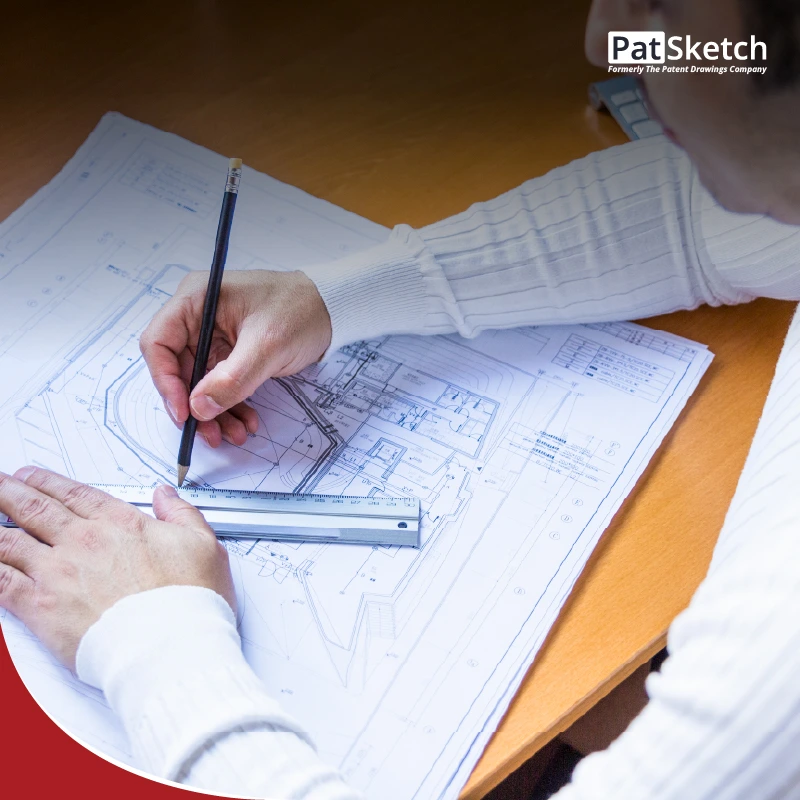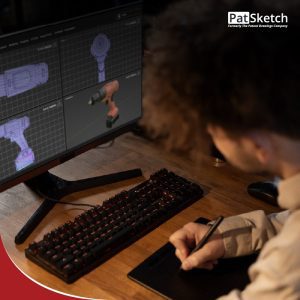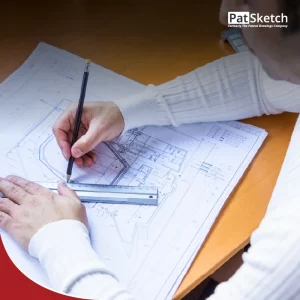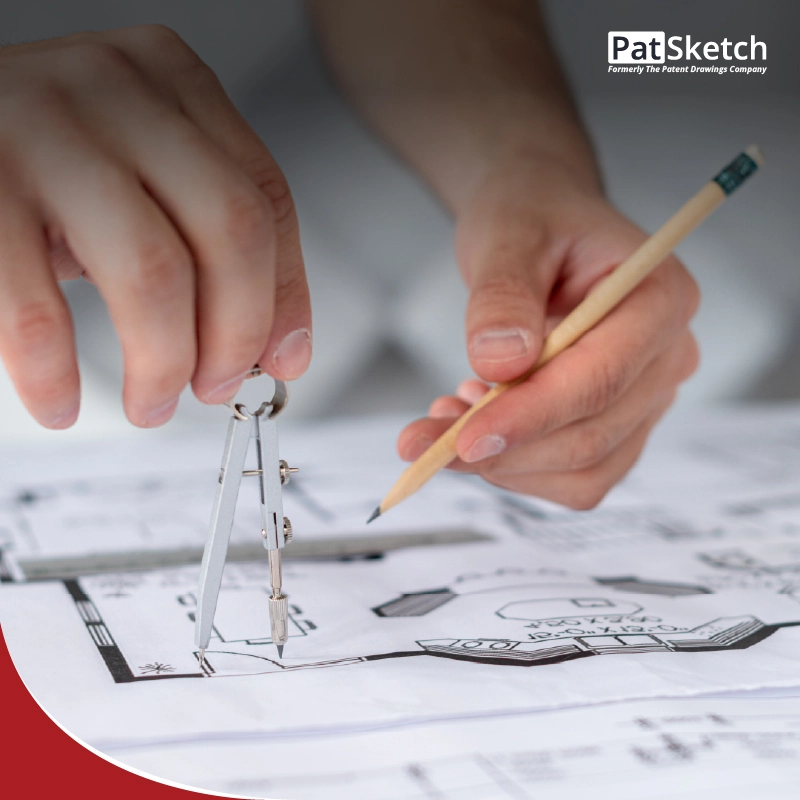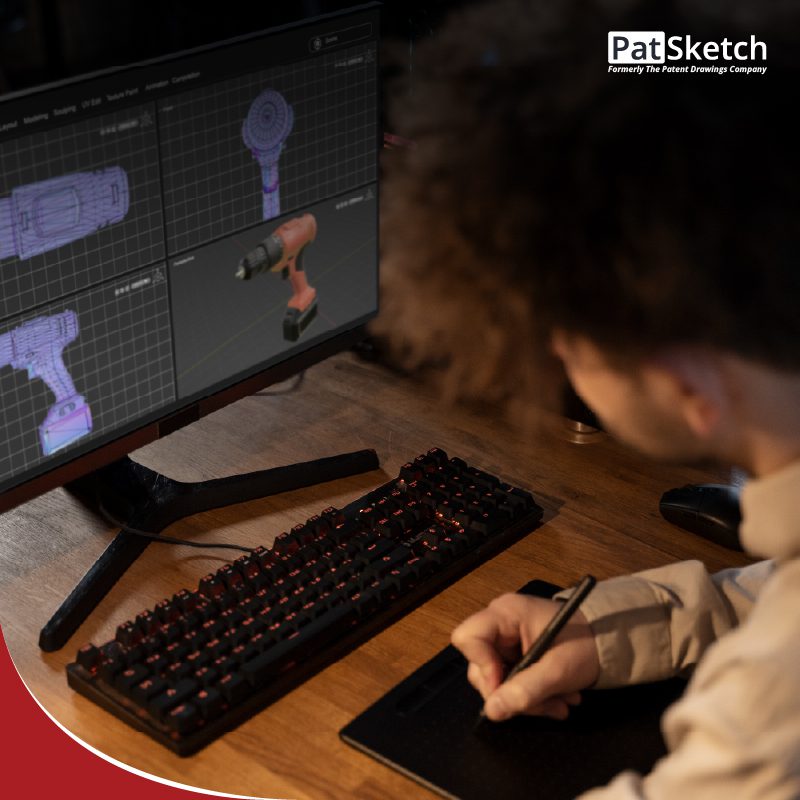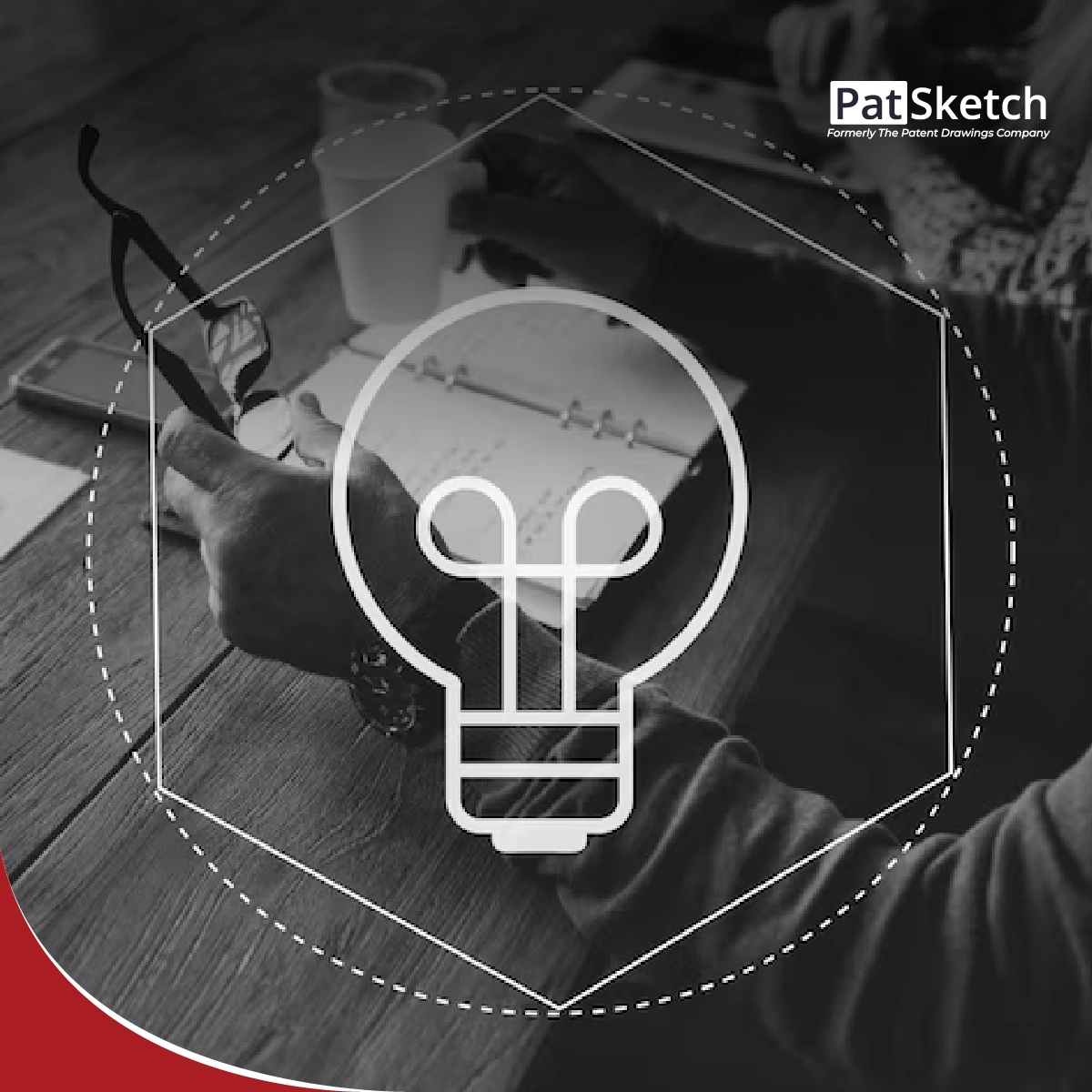What’s a Patent Drawing?
Think of a patent drawing as a detailed picture that shows exactly how an invention works. It’s like a visual guide that highlights all the important parts of the invention – from overall structure and components to internal mechanisms. The written explanation and specific claims in a patent application directly link to these drawings. You might see various perspectives in a patent drawing, such as the front, side, top, sectional, and exploded view where everything is spread out. All these different angles help to give a complete picture of the invention. The main reason for these drawings is to help patent examiners and others get a quick and clear grasp of the invention’s technical ins and outs.Why is Patent Drawing So Important?
Patent drawings are essential for a successful patent application. They serve multiple purposes, from clarifying complex ideas to meeting legal requirements:- Clarification of Complex Ideas: They break down intricate inventions into clear visual elements, helping to resolve ambiguities in the written description.
- Legal Requirement: Many patent offices (including the USPTO, WIPO, and EPO) require formal drawings as part of the application process. Noncompliance can result in delays or even rejection of the application.
- Enhanced Communication: Detailed drawings support the written claims by providing tangible evidence of the invention’s structure and operation.
- Establishing Novelty: High-quality illustrations can help differentiate your invention from prior art by emphasizing unique features.
- Cost and Time Efficiency: Well-executed drawings can reduce the need for multiple office actions, ultimately saving time and legal expenses.
Types of Patent Drawing
Patent drawings play a crucial role in illustrating an invention in a patent application. Depending on the type of patent, different styles of drawings are required to meet legal and technical standards. Below, we explore the three main types of patent drawings:
Figure 1: Three Different Types of Patent Drawings
1. Utility Patent Drawing
Utility patent drawings visually represent an invention’s function, structure, and improvements over prior art. These drawings align with the claims and descriptions in the patent application, helping to clearly explain how the invention works. Skilled draftspersons create these illustrations, ensuring they effectively highlight the problem the invention solves or its unique advantages. Utility patent drawings can include:- Line drawings depicting object shapes
- Block diagrams
- Flowcharts
- Electrical circuit schematics
- Chemical formulas
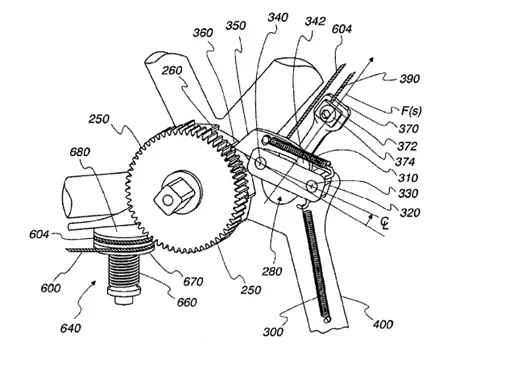
Figure 2: An Example of Utility Patent Drawing
2. Design Patent Drawing
Design patent drawings provide a complete visual representation of an invention’s appearance. They must be highly precise, leaving no room for interpretation, as they form the basis of the design patent claims. Most countries follow similar guidelines, requiring multiple views in black-and-white line art to fully showcase the design. In cases where line drawings aren’t sufficient, photographs may be allowed, though some jurisdictions only permit traditional black-and-white illustrations. These drawings emphasize the aesthetics of an invention, including its shape, contours, and material textures. Shading is often used to highlight these details. Unlike utility patent drawings, design patent drawings do not include reference numbers since they focus purely on ornamental design rather than function. Common examples are furniture, jewelry, computer icons, and beverage containers.
Figure 3: An Example of Design Patent Drawing
3. Plant Patent Drawing
Similar to design patent drawings, plant patent drawings do not use reference numbers. These illustrations can be in black and white or color, though the color is often preferred for better accuracy. The color drawing could be either in the form of photographs or prepared in permanent watercolor.
Figure 4: An Example of Plant Patent Drawing
Different angles are critical in fully conveying the invention and all its features and characteristics. In the next section, we will discuss several views that are used to explain the invention in patent drawings.Key Rules and Guidelines for a Patent Drawing
To ensure acceptance by the patent office, your drawings must conform to detailed standards. Here are the primary guidelines:- Color and Ink: Drawings are generally submitted in black ink on white, non-glossy paper. Color is rarely allowed except by petition when necessary.
- Paper Size and Margins: The USPTO requires that drawings be made on sheets that are either 8.5″ x 11″ (letter size) or A4, with minimum margins (e.g., at least 2.5 cm at the top and left 1.5 cm on the right, and 1.0 cm at the bottom)
- Scaling: Drawings must be executed at a scale that maintains clarity when reduced to two-thirds of the original size.
- Numbering and Labeling: Each drawing sheet must be numbered consecutively. Individual views within a sheet should also be labeled (e.g., “FIG. 1”) and reference characters must be used consistently.
- Line Quality and Shading: All lines must be clean, uniform, and dark enough for reproduction. Shading may be used to indicate contours or depth but must not obscure details.
- No Extraneous Marks: Drawings should be free of errors such as erasures, overwriting, or extraneous text within the “sight” area.
International Patent Drawing Standards
Patent drawing requirements vary across major patent offices. Understanding these differences is crucial for ensuring compliance when filing internationally.- USPTO (United States Patent and Trademark Office): In the United States, the USPTO mandates that drawings be executed in black ink on white, non-glossy paper with defined margins, proper scaling, and sequential numbering. Shading is allowed but must not obscure the details. These standards help ensure that every detail is reproducible and clearly understood. For detailed guidelines visit USPTO Patent Drawing Guidelines.
- EPO (European Patent Office): The EPO mandates that drawings be created on A4-sized paper with a usable area not exceeding 26.2 cm x 17 cm. Strict margins (e.g., 2.5 cm at the top and left 1.5 cm at the right, and 1.0 cm at the bottom) and uniform, clearly drawn lines are essential for clarity and consistent reproduction. If text is included in drawings, it must be in a standard font without handwriting or cursive styles. For detailed guidelines visit EPO Drawing Guidelines.
- WIPO/PCT (World Intellectual Property Organization/Patent Cooperation Treaty): Under the Patent Cooperation Treaty (PCT), drawings are required when they are necessary to understand the invention. WIPO’s guidelines emphasize durability, clarity (with no extraneous text), and reproducibility, ensuring that international applications meet a common standard across different jurisdictions.
Manual or Digital: Which is the Best Way to Create Patent Drawings?
When it comes to patent drawings, inventors have two main options: the old-school manual method or the modern digital route.- Manual Drawing: Traditional hand-drawn sketches offer a personal touch but let’s be honest, they can be time-consuming to fix if you make a mistake, and getting everything perfectly precise can be a real challenge.
- Digital Drawing: Using specialized software for your patent drawings has some serious perks:
- High Accuracy: Digital tools let you measure everything precisely, keep your scaling consistent, and maintain clean, uniform lines.
- Easy Revisions: Did you make a mistake? No problem! Digital edits are a breeze compared to starting from scratch on paper.
- Professional Presentation: Drawings made on a computer usually meet the strict standards of the patent office more easily, giving you a more professional look.
Common Mistakes to Avoid in Patent Drawings
Despite the clear guidelines, several common pitfalls can jeopardize your patent application:- Incomplete or Inaccurate Illustrations: Failing to depict every component or discrepancy between the drawings and written description.
- Poor Quality: Low-resolution images, uneven lines, and ambiguous shading can confuse examiners.
- Non-Compliance: Not adhering to specific patent office guidelines like incorrect paper size, improper margins, or inconsistent numbering.
- Overcomplication: Including unnecessary details or clutter that obscures the critical features of the invention.
- Inconsistent Labeling: Misnumbered reference characters or inconsistent use across different views.
- Faulty Scaling or Perspective: Distorted or incorrectly scaled views that misrepresent the invention’s dimensions.
Tips for Creating Effective Patent Drawings
Here are some tips to help you create effective patent drawings:- Use professional drafting software: CAD (Computer-Aided Design) software is super helpful for making clean and precise drawings. These programs have tools that help you keep a line thickness uniform and make sure everything is scaled correctly.
- Start with rough sketches: Begin by sketching things out in pencil. This way, you can get the overall layout and all the little details down first. Once you’re happy with the sketches, you can refine them and then either ink them or create a digital version.
- Maintain Consistency: All your different views must use the same scale, style, and reference numbers. A good idea is to create a checklist to make sure each drawing follows the respective patent office guidelines.
- Include multiple views: Use various perspectives of your invention from different angles. You can use exploded views or sectional views, for example, to give a complete picture.
- Review and revise: Double-check your drawings against the written description and claims in your patent application regularly. This helps ensure everything is accurate and consistent.
- Use clear annotations: Where necessary, add annotations to your drawings. Make sure the labels are easy to read, and the descriptions are short and to the point. These annotations should directly match the written portion of your patent.
- Leverage Professional Help if Needed: If you’re not confident in your drawing skills, consider hiring a professional patent illustrator who is familiar with the legal requirements.
How to Make Sure Your Patent Drawing Meets Legal Standards?
Before submission, it’s essential to review your illustrations according to the established legal standards:- Refer to Official Guides: Regularly examine the guidelines from the USPTO, EPO, and WIPO to confirm that your drawings adhere to the necessary standards.
- Get a Pre-Submission Check: Have a patent lawyer or a seasoned patent draftsman look over your drawings. Their expertise can identify potential problems that might result in official actions.
- Use Templates and Checklists: Many resources are available that provide standardized templates for patent drawings. These can help you avoid common formatting errors.
- Keep Detailed Records: Document revisions and maintain a master list of reference characters and views to ensure consistency throughout your application.
Is It Worth Hiring a Professional Patent Illustrator?
Opting for a do-it-yourself approach might seem like a good way to cut costs at first, but there are some solid advantages to bringing in a professional:- Accuracy is Key: Experienced illustrators know how to meticulously capture every detail and guarantee that all components are portrayed with precision.
- Saving Time: Outsourcing the drawing work can speed up your patent application and reduce your workload.
- Avoid Legal Issues: Experts know the ins and outs of patent office rules (like the USPTO, EPO, and WIPO) and are less likely to create drawings that cause problems or get rejected later.
- Better Presentation: A drawing done by a pro not only fulfills legal standards but also makes your invention look more polished and impressive overall.
Final Thoughts
Patent drawings aren’t just illustrations; they’re essential to your patent application. They connect the technical descriptions and practical understanding of your invention. By getting a good grasp of the different types of patent drawings, following the specific rules set by major patent offices, and steering clear of typical mistakes, you can seriously improve the strength and effectiveness of your application. Whether you decide to create the drawings yourself or bring in a professional, putting in the effort and resources to make clear, accurate, and compliant patent drawings will greatly increase your odds of securing strong patent protection.PatSketch: The Patent Drawings Company
PatSketch, offers expert patent drawing services designed to meet strict USPTO and international guidelines. Our team of skilled illustrators ensures that every detail, line weight, shading, numbering, and scaling is accurate and compliant. Whether you need high-quality utility patent drawings services to showcase functionality or detailed design patent drawing services to highlight aesthetics, PatSketch delivers drawings that eliminate guesswork and reduce the risk of rejection.

